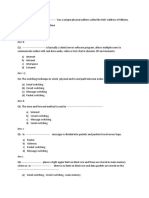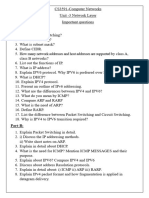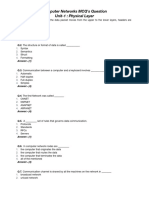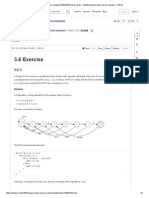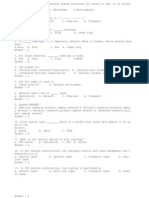Data Communication Chapter 1 Questions and Problems
Uploaded by
Thi Han LinnData Communication Chapter 1 Questions and Problems
Uploaded by
Thi Han LinnChapter 1 Questions and Problems
1.7.2 Questions
Q1-1. Identify the five components of a data communications system.
The five components of a data communication system are the sender, receiver, transmission medium, message, and
protocol.
Q1-2. What are the three criteria necessary for an effective and efficient network?
The three criteria are performance, reliability, and security
Q1-3. What are the advantages of a multipoint connection over a point-to-point one?
Advantages of a multipoint over a point-to-point connection is ease of installation and low cost.
Q1-4. What are the two types of line configuration?
The two types of line configuration are point-to-point and multipoint.
Q1-5. Categorize the four basic topologies in terms of line configuration.
The four basic topologies in terms of line configuration are
Point-to-point: mesh, star, and ring.
Multipoint: bus
Q1-6. What is the difference between half-duplex and full-duplex transmission modes?
In half-duplex transmission, only one entity can send at a time; in a full-duplex
transmission, both entities can send at the same time.
Q1-7. Name the four basic network topologies, and cite an advantage of each type.
The four basic network topologies and their advantages are
a. Mesh: secure
b. Bus: easy installation
c. Star: robust
d. Ring: easy fault isolation
Q1-8. For n devices in a network, what is the number of cable links required for a mesh, ring, bus, and star topology?
The number of cables for each type of network is:
a. Mesh: n (n – 1) / 2
b. Star: n
c. Ring: n – 1
d. Bus: one backbone and n drop lines
Q1-9. What are some of the factors that determine whether a communication system is, a LAN or WAN?
The general factors are size, distances (covered by the network), structure, and
ownership.
Q1-10. What is an internet? What is the Internet?
An internet is an interconnection of networks. The Internet is the name of a specific worldwide network.
Q1-11. Why are protocols needed?
A protocol defines what is communicated, in what way and when. This provides
accurate and timely transfer of information between different devices on a network.
Q1-12. In a LAN with a link-layer switch (Figure 1.8b), Host 1 wants to send a message to Host 3. Since communication is
through the link-layer switch, does the switch need to have an address? Explain.
No, the link-layer switch in a LAN does not need to have an address. The switch does not require an address of its own. Its
functionality is based on the MAC addresses of the devices connected to it and the MAC address table it maintains.
Q1-13. How many point-to-point WANs are needed to connect n LANs if each LAN should be able to directly communicate
with any other LAN?
Chapter 1 Questions and Problems 1
To connect n LANs in such a way that each LAN can directly communicate with any other LAN, (n-1) point-to-point WAN
connections are needed. This is known as a full-mesh topology. Therefore,(n x (n-1)) / 2 amount of point-to-point WANs are
needed.
Q1-14. When we use local telephones to talk to a friend, are we using a circuit-switched network or a packet-switched
network?
When we use local telephones to talk to a friend, we are using a circuit-switched network.
Q1-15. When a resident uses a dial-up or DLS service to connect to the Internet, what is the role of the telephone
company?
The telephone company's role includes providing the physical infrastructure and maintaining the connection between the
resident's premises and the ISP's network.
1.7.3 Problems
P1-1. What is the maximum number of characters or symbols that can be represented by Unicode?
Unicode uses 32 bits to represent a symbol or a character. We can define 232 different symbols or characters.
P1-2. A color image uses 16 bits to represent a pixel. What is the maximum number of different colors that can be
represented?
With 16 bits, we can represent up to 216 different colors.
P1-3. Assume six devices are arranged in a mesh topology. How many cables are needed? How many ports are needed for
each device?
Cable links: n (n – 1) / 2 = (6 × 5) / 2 = 15
Number of ports: (n – 1) = 5 ports needed per device
P1-4. For each of the following four networks, discuss the consequences if a connection fails. a. Five devices arranged in a
mesh topology b. Five devices arranged in a star topology (not counting the hub) c. Five devices arranged
in a bus topology d. Five devices arranged in a ring topology
a. Mesh topology: If one connection fails, the other connections will still be working.
b. Star topology: The other devices will still be able to send data through the hub;
there will be no access to the device which has the failed connection to the hub.
c. Bus Topology: All transmission stops if the failure is in the bus. If the drop-line
fails, only the corresponding device cannot operate.
d. Ring Topology: The failed connection may disable the whole network unless it
is a dual ring or there is a by-pass mechanism.
P1-5. We have two computers connected by an Ethernet hub at home. Is this a LAN or a WAN? Explain the reason.
LAN
P1-6. In the ring topology in Figure 1.7, what happens if one of the stations is unplugged?
In a ring topology, unplugging one station, interrupts the ring.
P1-7. In the bus topology in Figure 1.6, what happens if one of the stations is unplugged?
In a bus topology, unplugging one station, interrupts the bus.
P1-8. Performance is inversely related to delay. When we use the Internet, which of the following applications are more
sensitive to delay? a. Sending an e-mail b. Copying a file c. Surfing the Internet
a. E-mail is not an interactive application. Even if it is delivered immediately, it
may stay in the mail-box of the receiver for a while. It is not sensitive to delay.
b. We normally do not expect a file to be copied immediately. It is not very sensitive to delay.
c. Surfing the Internet is the an application very sensitive to delay. We except to
get access to the site we are searching.
P1-9. When a party makes a local telephone call to another party, is this a point-to-point or multipoint connection? Explain
the answer.
The communication is only between a caller and the callee. A dedicated line is established between them. The connection
is point-to-point.
Chapter 1 Questions and Problems 2
P1-10.Compare the telephone network and the Internet. What are the similarities? What are the differences?
The telephone network was originally designed for voice communication;
the Internet was originally designed for data communication.
The two networks are similar in the fact that both are made of interconnections of small networks.
The telephone network is mostly a circuit-switched network;
the Internet is mostly a packet-switched network.
Chapter 1 Questions and Problems 3
You might also like
- Data Communications and Networking 5th Edition Forouzan Solution Manual43% (30)Data Communications and Networking 5th Edition Forouzan Solution Manual5 pages
- Chapter 1 MCQs in Introduction To Data Communication100% (1)Chapter 1 MCQs in Introduction To Data Communication11 pages
- Computer Networking and Data Communication Solved Question Paper79% (14)Computer Networking and Data Communication Solved Question Paper51 pages
- Chapter 3 Data and Signals Exercise Question With Solution100% (6)Chapter 3 Data and Signals Exercise Question With Solution10 pages
- Chapter 1 - Introduction - Exercise Question With Solution92% (62)Chapter 1 - Introduction - Exercise Question With Solution5 pages
- Data Communication and Network Chapter 1No ratings yetData Communication and Network Chapter 17 pages
- Solution Manual For Data Communications and Networking by Behrouz ForouzanNo ratings yetSolution Manual For Data Communications and Networking by Behrouz Forouzan5 pages
- Chapter 2 - Communication: Distributed Systems (IT 441)No ratings yetChapter 2 - Communication: Distributed Systems (IT 441)59 pages
- CH 2 Data Communication Networking Network Model Multiple Choice Questions and Answers PDF Behrou PDFNo ratings yetCH 2 Data Communication Networking Network Model Multiple Choice Questions and Answers PDF Behrou PDF17 pages
- CH 15 Connecting LANs Backbone Networks and Virtual LANs Multiple Choice Questions Answers MCQ PDFNo ratings yetCH 15 Connecting LANs Backbone Networks and Virtual LANs Multiple Choice Questions Answers MCQ PDF12 pages
- CHAPTER 2: Network Models: Solutions To Review Questions and Exercises Review Questions100% (1)CHAPTER 2: Network Models: Solutions To Review Questions and Exercises Review Questions5 pages
- Data Communication and Networking Chapter - 350% (2)Data Communication and Networking Chapter - 3133 pages
- Books: (1) Data Communications and Networking 4 Or5 Edition - Behrouz A. Forouzan100% (1)Books: (1) Data Communications and Networking 4 Or5 Edition - Behrouz A. Forouzan20 pages
- Important Questions Computer Networks: Question BankNo ratings yetImportant Questions Computer Networks: Question Bank2 pages
- Objective Questions For Computer NetworksNo ratings yetObjective Questions For Computer Networks3 pages
- Review Questions: Identify The Five Components of A Data Communications System?No ratings yetReview Questions: Identify The Five Components of A Data Communications System?46 pages
- Ans of problems and questions in chap 1 NEM BOOK ChatGPT_Transcript_No ratings yetAns of problems and questions in chap 1 NEM BOOK ChatGPT_Transcript_15 pages
- Discussion Chapter#1 Main Points in Ch#1: - Data CommunicationNo ratings yetDiscussion Chapter#1 Main Points in Ch#1: - Data Communication7 pages
- Solutions To Review Questions and ExercisesNo ratings yetSolutions To Review Questions and Exercises4 pages
- Service Manual: Additive Injection System (AIS)No ratings yetService Manual: Additive Injection System (AIS)38 pages
- Ethical Hacking & Cyber Security Course - Massmatic Cyber Forensic & Information SecurityNo ratings yetEthical Hacking & Cyber Security Course - Massmatic Cyber Forensic & Information Security10 pages
- The Question Number On The Space Provided On Each Page of The Answer SheetNo ratings yetThe Question Number On The Space Provided On Each Page of The Answer Sheet4 pages
- Installation and Commissioning of Idirect Infiniti ModemsNo ratings yetInstallation and Commissioning of Idirect Infiniti Modems45 pages
- White Paper: Nurse Call Systems and IT Networks: Intelligent Life CareNo ratings yetWhite Paper: Nurse Call Systems and IT Networks: Intelligent Life Care12 pages
- Lab 3.5.3: Troubleshooting VLAN Configurations: Topology DiagramNo ratings yetLab 3.5.3: Troubleshooting VLAN Configurations: Topology Diagram4 pages
- RECOMMENDATION ITU-R F.1102-2 - Characteristics of Fixed Wireless Systems Operating in Frequency Bands Above About 17 GHZNo ratings yetRECOMMENDATION ITU-R F.1102-2 - Characteristics of Fixed Wireless Systems Operating in Frequency Bands Above About 17 GHZ12 pages
- TMM5400/470 Marking Systems: System OverviewNo ratings yetTMM5400/470 Marking Systems: System Overview12 pages
- ALS 2.2 Overview: Competence Assurance SystemNo ratings yetALS 2.2 Overview: Competence Assurance System27 pages
- Telecommunications, The Internet, and Wireless TechnologyNo ratings yetTelecommunications, The Internet, and Wireless Technology28 pages
- HughesNet HN9000 Satellite Modem User GuideNo ratings yetHughesNet HN9000 Satellite Modem User Guide94 pages
- A Guide To Building A Computer Networking CareerNo ratings yetA Guide To Building A Computer Networking Career7 pages
- Ubiquiti Home Network Project Instructions 2023100% (1)Ubiquiti Home Network Project Instructions 2023222 pages
- Computer Communication & Networks: Introduction To Data CommunicationNo ratings yetComputer Communication & Networks: Introduction To Data Communication28 pages












